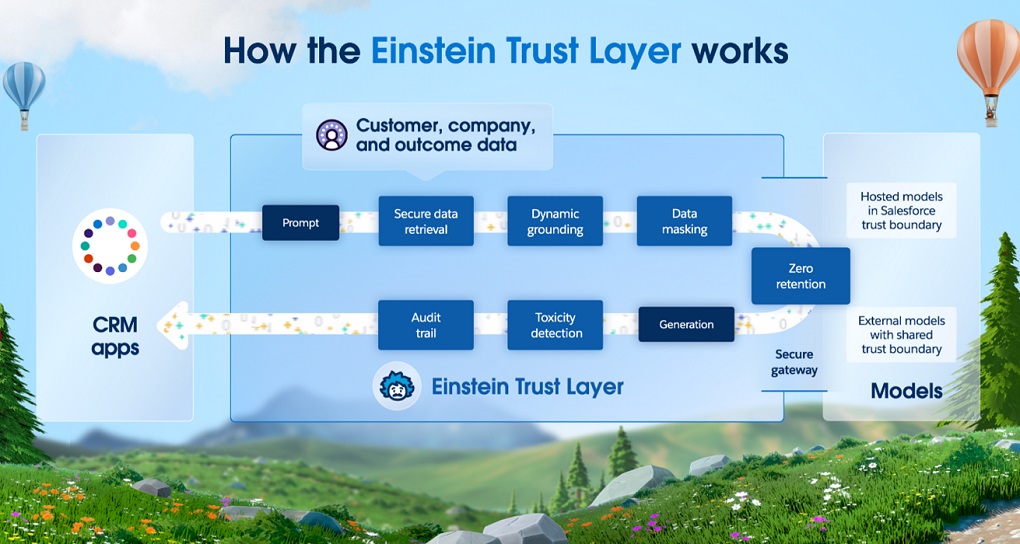
Einstein Trust Layer: Revolutionizing Data Security and Integrity
The Einstein Trust Layer (ETL) is an advanced framework that strengthens data security and integrity in a world where digital trust matters most. Designed to protect sensitive information, ETL offers a robust system for managing, processing, and securing data. Its primary goal is to safeguard data privacy while ensuring efficient data interactions, making it perfect for industries with strict privacy requirements, such as healthcare, finance, and governance.
How Einstein Trust Layer Works
To better understand how the Einstein Trust Layer operates, let’s first examine how data flows through the Trust Layer and then walk through each stage of the process in detail.
Initially, data in the form of a prompt flows from CRM apps, passes through the ETL, and reaches the large language model (LLM)—we’ll refer to this as the prompt journey.
The LLM then generates a response based on the prompt, a process we’ll call response generation.
Finally, the generated response travels back through the ETL and returns to the CRM apps, completing the process we’ll call the response journey.
1. Secure Data Retrieval
The Secure Data Retrieval of Salesforce information for prompt grounding is based on the permissions of the user executing the prompt. It maintains all standard Salesforce role-based controls for user permissions and field-level security when merging grounding data from your CRM instance or Data Cloud.
2. Dynamic Grounding
Dynamic Grounding, an innovative feature of the Einstein Trust Layer, merges the prompt with relevant information from a Salesforce record to provide context.
3. Prompt Defense
System policies play a crucial role in limiting hallucinations and reducing the chances of unintended or harmful outputs by the LLM. Additionally, these policies can vary depending on the specific generative AI features and use cases.
4. Data Masking
Data Masking is an essential technique used by ETL to protect sensitive information. Sensitive data is detected and masked prior to sending the prompt to the LLM. Moreover, data masking supports multiple regions and languages. Additionally, you can choose what to mask and what not to mask.
5. Zero-Data Retention Policy
Third-party LLMs do not retain your data. In fact, they collaborate with Open AI and Azure Open AI to uphold a zero-data retention policy. Furthermore, third-party LLMs do not use your data for model training or product enhancements. Additionally, no human at the third-party provider reviews the data sent to their LLM.
6. Toxicity Detection
The Toxicity Detection feature plays a crucial role in identifying harmful or inappropriate content within datasets. The Einstein Trust Layer evaluates content for toxicity. Furthermore, the system logs and stores toxicity scores in the Data Cloud, making them an integral part of the audit trail.
7. Auditing
Finally, the Auditing feature of the Einstein Trust Layer provides a comprehensive tracking and logging mechanism to monitor all data interactions. The system logs and stores prompts, responses, and trust signals in the Data Cloud. Additionally, you can leverage feedback to improve prompt templates. Moreover, the system provides pre-built reports and dashboards for in-depth analysis.
Conclusion
In conclusion, the Einstein Trust Layer is an innovative framework that elevates the standard for data security, privacy, and integrity. By combining advanced features like Zero-Data Retention, Dynamic Grounding, and Secure Data Retrieval, ETL ensures sensitive information remains secure. Moreover, as data breaches and privacy concerns rise, solutions like the ETL are crucial for building trust. Ultimately, they help maintain the highest security standards.
Sources
- Video Explaining the Einstein Trust Layer
- Einstein Trust Layer
- ETL Region and Language Support
- Set up Einstein Trust Layer






